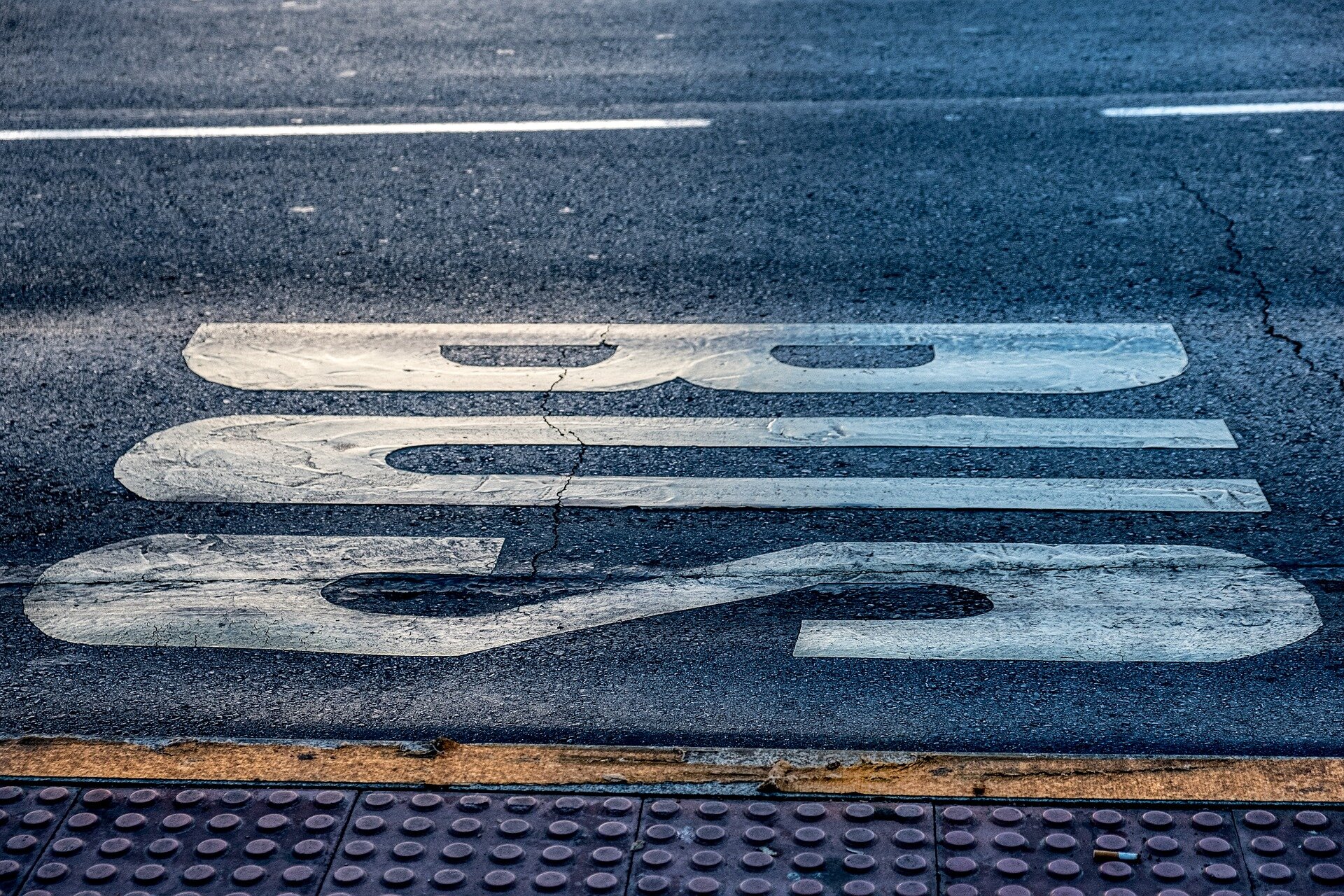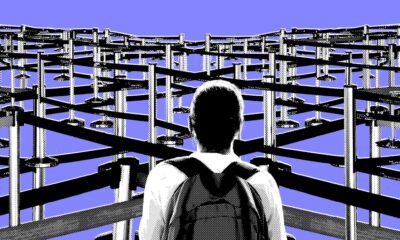Tech
Pedestrian deaths at midblock bus stops found to be up to 5 times higher

Bus transportation is an essential part of nearly every public transit system. From school students to everyday workers, riders depend on buses to transport them to the essential destinations. Because most passengers start or end their journey by walking, providing safe access to bus stops is key to enhancing pedestrian safety.
Pedestrian fatalities in the United States have significantly increased in recent years, with 2022 recording the most fatalities since 1981. While prior studies have analyzed bus stop safety using crash data, not all crashes near bus stops were directly related to the stop itself.
Candace Brakewood, an associate professor in the Department of Civil and Environmental Engineering, worked with Graduate Research Assistant Allison Rewalt and fellow CEE Professor Chris Cherry to address this gap by analyzing fatal transit bus stop-related pedestrian crashes from the Fatality Analysis Reporting System (FARS) and comparing them to other nearby fatal pedestrian crashes.
Their research, titled “An analysis of pedestrian safety at bus stops using FARS data,” was recently published in the Journal of Safety Research.
The research was funded through the Center for Pedestrian and Bicycle Safety(CPBS), which is a Tier I University Transportation Center (UTC) that is led by the University of New Mexico and includes UT, and a Dwight D. Eisenhower Graduate Fellowship that Rewalt received.
“Our work is unique because most prior studies used a more localized approach, relying on local or state crash data to understand the risks pedestrians face when walking to or from bus stops, whereas ours uses a national dataset to give us a bigger picture of what these risks look like nationwide,” Rewalt said. “Because our work is generalizable, it can be used to inform bus stop safety improvements across the country.”
Midblock stops present danger
The study uses pedestrian crash data that explicitly identifies bus stop-related crashes, providing a more nuanced assessment of crash risk factors for transit passengers and other pedestrians in the area, compared to previous studies that relied simply on proximity or other measures.
One of the key takeaways from the research is that there are three typical types of crashes that result in pedestrian fatalities at bus stops:
- pedestrians crossing to/from a bus stop at an intersection
- pedestrians waiting on the roadside at a midblock stop
- pedestrians crossing to/from a midblock stop.
Midblock stops are especially high risk, especially on high-speed arterials. Midblock locations increased the chances of a fatal crash by 4.7 to 5.2 times depending on the size of the buffer zone used in the analysis.
Pedestrians waiting on the roadside at a midblock stop is a crash subtype that is distinct to transit passengers, who often wait at the roadside for the bus to come, whereas other pedestrians would typically not be standing on the roadside for an extended period of time.
“This finding stood out because it points to a practical place to focus safety improvement near bus stops,” Rewalt said.
Finding infrastructure solutions
The UT researchers are hoping city planners, traffic engineers, and transit agencies can use their research findings to explore solutions to mitigate risk for pedestrians accessing buses. High-visibility crosswalks, especially at midblock crossings, or relocating bus stops closer to a signalized intersection could be infrastructure improvements to consider.
“We have an ongoing follow-up research project that continues to explore pedestrian safety at bus stops using a different nationwide dataset called CRSS that includes non-fatal crashes,” Brakewood said. “The overarching goal is to identify bus stop-related crash characteristics and determine which factors lead to more severe outcomes. We will have more results to share on the new project in the near future.”
Citation:
Pedestrian deaths at midblock bus stops found to be up to 5 times higher (2025, October 25)
retrieved 25 October 2025
from https://techxplore.com/news/2025-10-pedestrian-deaths-midblock-bus-higher.html
This document is subject to copyright. Apart from any fair dealing for the purpose of private study or research, no
part may be reproduced without the written permission. The content is provided for information purposes only.
Tech
Trump Signs Executive Order That Threatens to Punish States for Passing AI Laws

President Donald Trump signed a highly anticipated executive order on Thursday that sets in motion a plan to establish a national regulatory framework for artificial intelligence while undercutting states’ abilities to enact their own rules.
The order, titled “Ensuring a National Policy Framework for Artificial Intelligence,” creates an AI litigation task force within the Justice Department to directly challenge state AI laws the administration finds to conflict with federal policy. It also directs the Department of Commerce to craft guidelines that could make states ineligible for future broadband funding if they pass “onerous” AI laws.
The push for sweeping federal preemption of state AI laws has largely been fueled by AI investors, conservative policy shops, and tech industry trade groups. These groups have argued that a patchwork approach to AI regulation could stunt Silicon Valley’s AI boom and reduce America’s competitiveness on the global stage. White House AI and crypto adviser David Sacks has been one of the most vocal proponents of a light-touch approach to AI regulation.
“The EO gives your administration tools to push back on the most onerous and excessive state regulations,” Sacks told Trump during Thursday’s signing ceremony. “We’re not going to push back on all of them. For example, kids safety we’re going to protect.”
The order is similar in many respects to an earlier draft obtained by WIRED but with a few key differences. The executive order instructs Sacks and Michael Kratsios, the assistant to the president for science and technology, to prepare a legislative recommendation establishing a federal policy framework for AI. One of the new additions is a carve-out within this legislative recommendation asking Congress not to preempt state AI laws that aim to protect children, promote data center infrastructure, and encourage state governments to procure AI tools.
“We want one central source of approval, and we have great Republican support. I think we probably have Democrat support too, because it’s common sense,” Trump said during Thursday’s signing ceremony. “Every time you make a change, and it could be a very reasonable change, you still won’t get it approved if you have to go to 50 states. This centralizes it.”
In the absence of federal regulations, officials from states across the country have pushed through their own investigations and legislation to govern the use and development of AI. Trump’s executive order specifically calls out certain state AI laws—such as Colorado’s SB24-205, which aims to limit “algorithmic discrimination” in AI models—as an attempt to “embed ideological bias.”
Several other state AI laws may also fall in the crosshairs of this executive order. California governor Gavin Newsom signed a law in September requiring large tech companies to publish safety frameworks around their AI models. In June, New York’s legislature passed a bill that would empower the state’s attorney general to bring civil penalties of up to $30 million against AI developers that fail to meet safety standards. That bill is currently sitting on New York governor Kathy Hochul’s desk, awaiting her signature or veto—though she’s reportedly considering amendments that could weaken the bill significantly.
Tech
Crypto Magnate Do Kwon Sentenced to 15 Years in Prison

South Korean crypto entrepreneur and prosecuted fraudster Do Kwon was sentenced to 15 years in prison by a US federal judge in the Southern District of New York on Thursday.
Kwon cut a solemn figure as he was escorted into the courtroom by US Marshals, his head bowed, his cheeks sunken as if he’d lost a significant amount of weight. He wore a bright lemon-colored prison jumpsuit over a long-sleeve shirt, with cuffs around his waist and hands.
In August, Kwon pleaded guilty to defrauding investors who purchased crypto coins issued by his company, Terraform Labs. In May 2022, the abrupt collapse of those coins wiped out $40 billion and sent the crypto economy into a tailspin that bankrupted numerous other companies.
“Kwon’s fraud was colossal in scope, permeating virtually every facet of Terraform’s purported business,” US prosecutors wrote in a recent court filing. “His rampant lies left a trail of financial destruction in their wake.”
Given the chance to address the court on Thursday, Kwon said he took sole responsibility for the fraud. After thanking his former coworkers and supporters, some of whom had gathered in the public gallery, he became emotional. His lawyers, to his left and right, rubbed his back.
The offenses to which Kwon pleaded guilty carry a maximum sentence of 25 years in prison. Before the hearing, prosecutors had petitioned for a 12-year prison term. But the presiding judge, Paul Engelmayer, ruled that a more punitive sentence was required in order to deter future crypto fraudsters.
“This case will be there as a reminder of breaking bad and what happens,” Engelmayer told the courtroom. “To the next Do Kwon, if you commit fraud, you will lose your liberty for a long time.”
As he was bundled into an elevator outside the courtroom after receiving his sentence, Kwon appeared to be holding back tears. The chain that hung between his feet rattled against the floor.
Not-So-Stablecoin
Kwon started Terraform in 2018, alongside cofounder Daniel Shin. Two years later, the company announced plans to launch TerraUSD (UST), a stablecoin whose value was supposedly pegged to the US dollar by way of an algorithm. The algorithm would effectively tie UST to a second coin issued by the firm, LUNA. A dollar’s worth of LUNA could be exchanged for a dollar’s worth of UST, and vice versa. If UST were to ever slip below $1, traders would be incentivized to buy LUNA until the target value was restored.
“It was an intriguing and very novel mechanism,” Noelle Acheson, an analyst who previously worked at the crypto brokerage Genesis, told WIRED last year. “Many smart people believed it would work.”
In May 2022, the price-balancing system belched. When traders sold large quantities of UST, it slipped from its dollar peg, leading to a panicked sell-off that drove the price practically to zero. In a now-infamous tweet, Kwon tried to stop the selloff, writing, “deploying more capital—steady lads.” But the value of UST and LUNA plummeted, wiping $40 billion from the market.
Tech
RFK Jr.’s Health Department Is Pondering a National Men’s Health Initiative

The US Department of Health and Human Services is considering launching a federal men’s health initiative, a source at the agency tells WIRED.
Brian Christine, who will be sworn in on December 12 as assistant secretary for health at HHS and head of the United States Public Health Service Commissioned Corps, called for such an effort Wednesday during a Food and Drug Administration panel on testosterone replacement therapy (TRT) for men. A spokesperson for HHS declined to comment.
“We have a men’s health crisis in this country. Now we need a national strategy,” he said as part of a call for creating so-called Men’s Health Centers of Excellence across the country that would collaborate with each other, share information, and generate data to inform policy and programs around men’s health.
Participants in Wednesday’s FDA panel—which included federal health officials, urologists, experts on male sexual health, and the CEO of a TRT pharmaceutical company—voiced support for expanding the eligibility criteria for TRT and removing testosterone from the FDA’s controlled substances list. Earlier this year, the FDA held a similar panel on hormone replacement therapy for menopausal women and announced in November that it would remove a black box warning from the medications.
The Trump administration has aggressively canceled equity and transgender initiatives across the government and cut hundreds of millions of dollars in funding for research into women’s and LGBTQ health.
During the panel discussion, Christine called attention to men’s health more broadly, pointing out the widening gender gap in life expectancy in the US and that 44 percent of men surveyed in 2023 didn’t get an annual physical. While rates of depression are similar among men and women, men are much less likely to seek treatment despite suicide rates in the US being much higher in men. Substance abuse compounds that problem, he said, with the majority of opioid overdoses occurring in men.
“There are fewer federal programs targeting men’s health concerns than women,” Christine said. “None of this suggests that we should back off our commitment to women’s health. No—never. But we do need a parallel track for men’s health in this country.”
Christine also couched men’s health concerns, particularly obesity, as a national security issue. “Men’s health concerns truly affect defense preparedness, defense readiness and the safety of this country against our enemies,” he said, adding that obesity is a barrier to serving in the military.
-

 Sports7 days ago
Sports7 days agoAustralia take control of second Ashes Test | The Express Tribune
-

 Business1 week ago
Business1 week agoAsian stocks today: Markets trade mixed ahead of US economic data; HSI nears 1% loss; Nikkei adds over 800 points – The Times of India
-

 Politics5 days ago
Politics5 days ago17 found dead in migrant vessel off Crete: coastguard
-

 Entertainment1 week ago
Entertainment1 week agoSabrina Carpenter recalls ‘unbelievable’ experience with pal Taylor Swift
-

 Fashion1 week ago
Fashion1 week agoBangladesh’s economic outlook cautiously optimistic: Govt
-

 Fashion4 days ago
Fashion4 days agoGermany’s LuxExperience appoints Francis Belin as new CEO of Mytheresa
-

 Politics4 days ago
Politics4 days agoThailand launches air strikes against Cambodian military: army
-

 Tech1 week ago
Tech1 week agoThe Trump Administration Wants Immigrants to Self-Deport. It’s a Shit Show


















